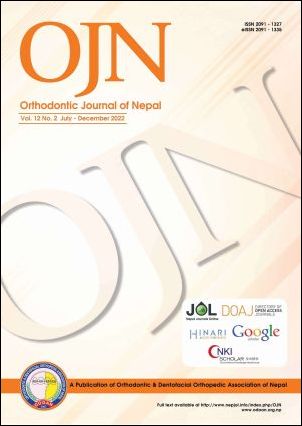Comparative evaluation of smile attractiveness in various orthodontic treatment modalities- A cross-sectional study
DOI:
https://doi.org/10.3126/ojn.v12i2.38228Keywords:
Extraction, Non-extraction, Smile, Facial esthetics, Orthodontic treatmentAbstract
Background: Smile plays a significant role in facial attractiveness and social interactions. The present study aimed to evaluate the smile attractiveness in subjects treated with extraction or non-extraction orthodontic treatment modality.
Materials and Methods: Frontal smiling photographs of 100 orthodontically treated subjects with an age range of 16-25 years were taken and divided into two groups each having 50 subjects. Group I (ANB 0° to 4° ) was subdivided into cases treated with extraction (group la) and without extraction (group lb). Similarly, Group II (ANB > 4°) was subdivided into cases treated with extraction (group lla) and without extraction (group lib). Smile esthetics and esthetic scores were assessed on frontal smile photographs by using different smile variables objectively and with the help of raters (10 laypersons,10 dental graduates, and 10 orthodontists) subjectively.
Results: In extraction cases, the esthetic scores of dental practitioners and orthodontists were higher than in cases of non-extraction. Between extraction and non-extraction cases, laypeople had no esthetic preference. In Skeletal class I, smile variables such as the arch form index, smile arc and maxillary incisor show had a higher value in extraction cases however, the buccal corridor was more in non-extraction cases. In Skeletal Class II, smile variables such as the maxillary incisor show and arch form index were more in extraction cases and exposure of mandibular teeth was more in non-extraction cases. Judgement given by the raters was mainly based on maxillary incisor show, number of teeth displayed, and buccal corridor ratio. In orthodontic patients treated with and without the extraction, statistically non-significant variations in smile esthetics and esthetic scores were found.
Conclusion: Thus, a decision regarding the extraction of teeth in orthodontic patients should not be solely based on smile esthetics but other factors which determine extraction should be considered.
Downloads
Downloads
Published
How to Cite
Issue
Section
License
Copyright (c) 2023 Orthodontic & Dentofacial Orthopedic Association of Nepal

This work is licensed under a Creative Commons Attribution 4.0 International License.
Copyright © held by Orthodontic & Dentofacial Orthopedic Association of Nepal
- Copyright on any research article is transferred in full to the Orthodontic & Dentofacial Orthopedic Association of Nepal upon publication in the journal. The copyright transfer includes the right to reproduce and distribute the article in any form of reproduction (printing, electronic media or any other form).
- Articles in the Orthodontic Journal of Nepal are Open Access articles published under the Creative Commons CC BY License (https://creativecommons.org/licenses/by/4.0/)
- This license permits use, distribution and reproduction in any medium, provided the original work is properly cited.




